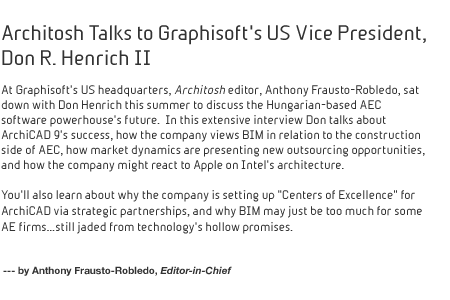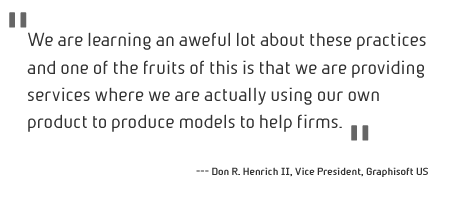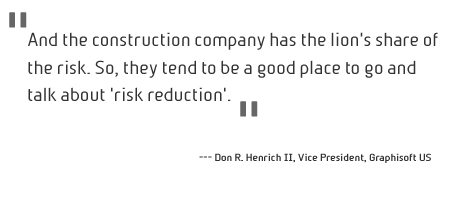| 
page
| 1 | 2 | 3 | 4 |
[Don]
If they are an Autocad shop...
[AFR]
Are you finding that?
[Don]
Yeah, if they are coming from Autocad that may be their
inclination, but it really depends if we have jumped
out and touched them. That maybe their default position.
It is our job to get out there and let people know there
are alternatives.
We
need to continue to educate the market. A
lot of people do know of us. We get lots of calls from
people. But it usually ends up us and Revit.
[AFR]
I see.
[Don]
You know I classify architectural practices one of
three types: I'm 2D and I don't want to change. I'm
2D and I want to change and I'm going to call Autodesk.
And thirdly, I'm 2D and I want to change, but I don't
know what I want to buy and I want to look at the market.
I think that really captures all three constituencies.
So
the guys that are 2D and don't want to change are the
laggards. You will get some of those but they are tough
nuts, tough nuts to crack. The middle group, are like
what your question asked, they will automatically call
their dealers if they are Autocad guys. And the
last case is the big group, where a lot of folks are
saying
they want to look at the market and will call us in to
talk to them. And if we come in, and they genuinely go
through the presentation and we do a good job, then yes,
we do very well that way.
[AFR]
Right, and I would think in the third case, you get firms
that say, okay, we understand that BIM is where we need
to go ultimately, so we are doing this now -- as a starting
point -- whereas the second group, they will say: we'll
invite the Autodesk folks in. They may be contemplating,
okay, we are going to compare Autocad to Revit, which
is really comparing two different types of approaches...
[Don]
Hmm, yes that is right...
[AFR]
...with the trial being, sort of, if Revit doesn't work,
then we'll fall back on Autocad. And I would imagine
that in the case of those trials that there is a percentage
that do indeed do that, fall back, because in the case
of Revit, it isn't quite working for them, on some level.
[Don]
Yes, and I think a lot of them -- of that middle
constituency -- are quite jaded, because they had a
reasonable unpleasant experience with ADT (Architectural
Desktop).
[AFR]
Now you have a new product that really addresses
BIM on the construction level. Can we talk about that?
[Don]
Sure.

[AFR]
Some people have suggested that Graphisoft has not entirely
given up on trying to take market share from Autodesk
but instead is doing an end-run around them by planting
the seed of
BIM in the construction sector itself, sort of creating
an island in which the architecture -- design side -
can reach over to.
[Don]
I think that is fair to say. In the strategic sense,
that is a way to compete with an opponent, to change
the
rules. I would say that is a fair statement. We are planting
seeds, if you will, in places that are causing wonderful
collaborations, and we are reaping those benefits and
they are fabulous. We are learning
an awful lot about these practices and one of the fruits
of this is that
we are providing services where we are actually using
our own product to produce models to help firms.
[AFR]
What size construction firms are adopting the Construction
BIM product, Graphisoft Constructor 2005?
[Don]
Generally they are quite large. There are also smaller
firms adopting. But most of our Constructor 2005 customers
produce over $500 million in annual sales. Large companies
like Turner Construction come to mind. Another is Webcor,
in California.
We
also have the designbuild guys who often have a sole
practice,
or a ten-man firm and they are organized around collaborating
with others and they are also onboard.
[AFR]
Right, these are the early adopter, technology-favored
firms
[Don]
Yeah, and we
have focused on the larger folks because they tend to
have more pull in the market. Pushing is okay, but pulling
is always better, right?
[AFR]
So in this case are you really hoping for an architect
to get in a situation where if they are working
for a large client and there is a builder already onboard
and they say, "we really want you to be our architect
but you
have to use ArchiCAD so you can integrate into our builder's
technology," is that something you are sort of looking
at?
[Don]
Yeah. Absolutely, and it's working. It's just starting
but it's working well. And as I mentioned earlier, we
have started to see technology-based firms working with
object-based frameworks that can really help this industry.
We are
documenting it, sharing it with our early adopters.
And we think, of course, we will be a big winner too.
And our early
adopters will be big winners.

[AFR]
You are describing a scenario now where the construction
folks are kind of the magnet, they are pulling everyone
else.
[Don]
Well, ...yes, it kind of makes sense, because everyone
that is in a project carries insurance for errors and
omissions. But the people that carry the most insurance
-- and pay the most in both premiums and risk -- are
the construction guys.
You
know the owner is usually pretty
firm about
what he wants, and the architect and the construction
company -- combined with the engineering -- have to
live up to that. And the construction
company has the lion's
share of the risk. So, they tend to be a good place
to go and talk about 'risk reduction'.
[AFR]
You know recently I published an interview with Nemetschek
North America CEO, Sean Flaherty, and he said he thought
there were two types of BIM, construction BIM and design
BIM -- and that BIM was bifurcating the market. Do you
see that happening?
[Don]
There are two different applications of the technology.
Our vision is that those become one. And we are working
hard to facilitate that. For example, you can develop
a building in ArchiCAD and put the model right into the
Constructor Series products to get your estimation data.
[AFR]
And essentially, all your products both design-oriented
and construction-oriented are all based on the ArchiCAD
engine? Is that correct?
[Don]
Yes. So we do aspire to have the same
model have multiple and different uses.
[AFR]
So you feel it is necessary to build out products on
the same code base, not just because it simplifies code
development but because of the necessity of the data
transfer. Would that be fair to say?
[Don]
Yes, ArchiCAD is a great modeler, so if you need a model,
why reinvent it, why send it to some other state?
[AFR]
Maybe because someone else does modeling better?
[Don]
ArchiCAD is a very powerful and proven modeler that can also
tap other modelers.
You
know we have a new and powerful connection to SketchUP
and we also have a new jointly developed tool called
MaxonForm. So Form is a surface modeler and it runs inside
ArchiCAD. And you can create an object in Form -- like a
really beautiful curtain wall, or a
roof, and ArchiCAD will bring that in as an ArchiCAD
object.
You can do everything we can typically do with it.
[AFR]
So even though it was created physically in MaxonForm, it functions
just like you created it in regular ArchiCAD?
[Don]
Yes. We are very happy with version 9, but we aren't happy
enough. So we sought out new ways to make it better,
to extend its power. For
example, we are meeting with a company in the next room
about energy analysis. We are working
to make ArchiCAD green.
[AFR]
Green as in energy conservation?
[Don]
Yes.
[AFR]
So you have some interesting stuff in the pipeline then?
[Don]
Absolutely. The SketchUp and MaxonForm stuff is 'upfront'
technology, but we are working on 'output' stuff with
energy
studies and other items.
The
eco system around 9 is much larger than what we had before
with version 8. We have E-Tabs structural analysis
integration (an IFC based connection). And we do motion
studies, green
energy studies; but in future versions of ArchiCAD we will
move forward on our "architectural simulation" ecosystem.
[AFR]
Such as?
[Don]
I'm not at liberty to discuss future products with the
media.
[AFR]
I completely understand. Companies need to protect their leadership
and it's fair to say that Graphisoft has been the
market defining BIM leader for...nearly two decades now.
Let's
talk about BIM from the view of interoperability with
other software systems. What is Graphisoft's view of
this moving forward? How does BIM ever become truly useful
if deep interoperability can't occur?
Continued >
page
| 1 | 2 | 3 | 4 |
|






![]()
![]()